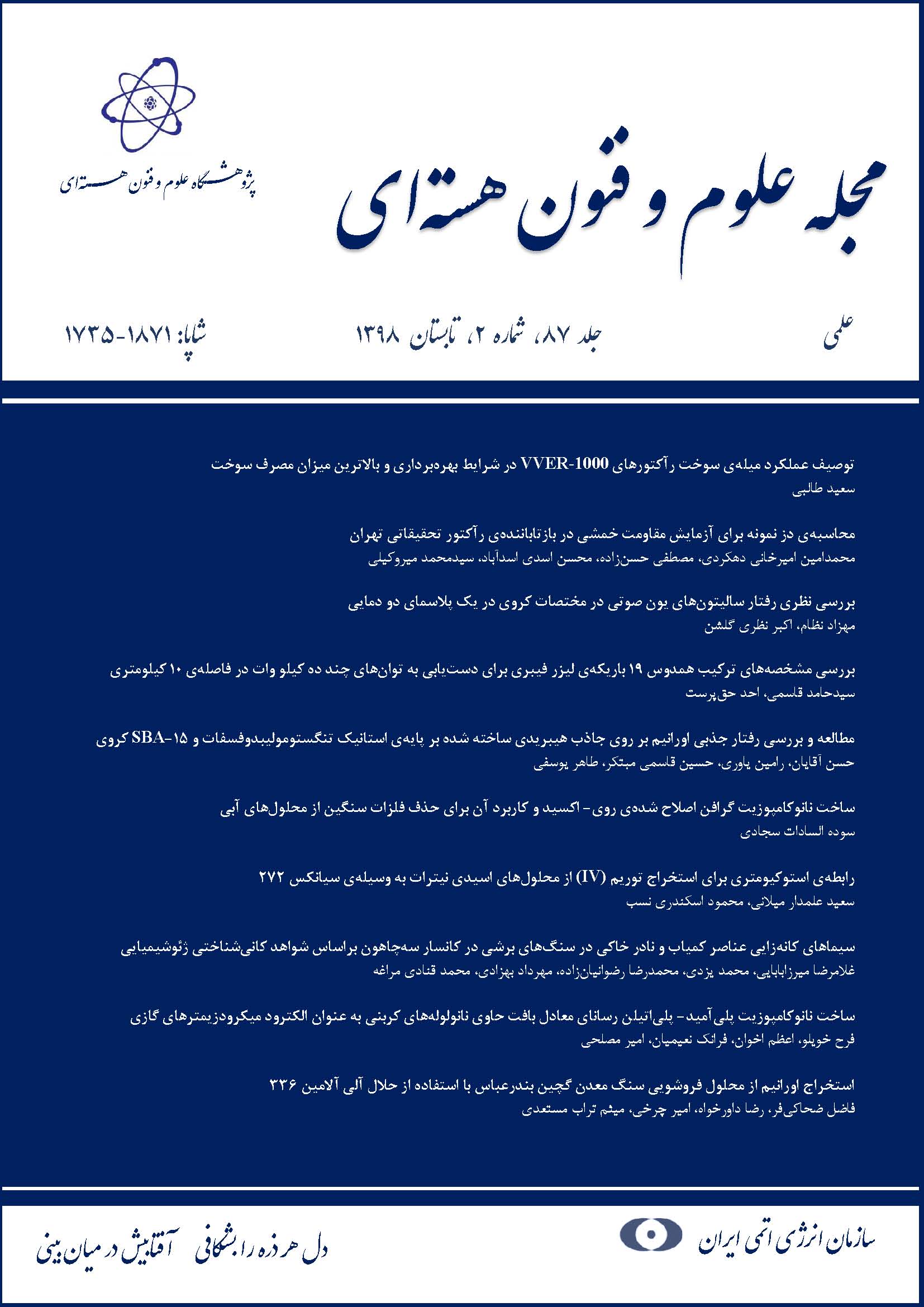نوع مقاله : مقاله پژوهشی
نویسندگان
پژوهشکدهی راکتور و ایمنی هستهای، پژوهشگاه علوم و فنون هستهای، سازمان انرژی اتمی ایران، صندوق پستی: 1339-14155، تهران ـ ایران
چکیده
ایمنی در هر نوع آزمایش یکی از موارد بسیار مهم است. آزمایش خمش از جمله آزمونهای مهم برای دستیابی به مشخصههای مواد است. در این مقاله، نرخ دز نمونهی استاندارد برای آزمایش خمش گرافیت در رآکتور تحقیقاتی تهران به دست آمد. با استفاده از استانداردهای مختلف مقدارهای دز در فاصلههای مختلف و دو بازهی زمانی 15 و 40 روز تابشدهی محاسبه شد. محاسبهها با استفاده از دو کد اوریجین و ام. سی. ان. پی. ایکس انجام شد. مقدارهای ناخالصی ماده با استفاده از دو تکنیک فلوئورسانی پرتو ایکس (XRF) و طیفسنجی نشر اتمی پلاسمای جفت شدهی (ICP-AES) اندازهگیری شد. نتیجههای محاسبهها نشان داد که استاندارد کلیبورن و تروبی از استانداردهای دیگر سختگیرانهتر بوده و نمونه پس از گذشت 20 روز از تابشدهی با رعایت فاصلههایی در حدود cm 100 دارای دز کمتر از 1-μSv h 2 برای انجام آزمایشها است. همچنین محاسبههای مربوط به محفظهی انتقال نشان داد که محدودیتی در انتقال نمونهها وجود ندارد. در نهایت میتوان گفت روش به کار گرفته شده در این پژوهش میتواند برای دیگر مواد موجود در قلب رآکتور نیز مورد استفاده قرار گیرد.
کلیدواژهها
عنوان مقاله [English]
Sample dose calculation for flexural strength test in Tehran research reactor reflector
نویسندگان [English]
- M.A Amirkhani
- M Hassanzadeh
- M Asadi Asadabad
- S.M Mirvakili
چکیده [English]
Safety is one of the most critical issues in any test. The flexural test is a significant one to obtain material specifications. In this paper, a standard sample dose rate was calculated for the graphite flexural test in Tehran research reactor. Using different standards, the dose was computed at different distances and two periods of radiation, 15-40 days. Our calculations were performed with the ORIGEN and MCNPX codes. The impurity amounts of the material were measured by two methods of X-ray Fluorescence (XRF) and Inductively Coupled Plasma, Atomic Emission Spectroscopy (ICP-AES). The obtained results show that the Claiborne & Trubey standard is more stringent than other standards, and it has less than 2 μSv/h dose with the observance of 100cm distance and 20 days after irradiation. Moreover, calculations of the transfer chamber indicate that there is no limitation for the transport of the samples. Finally, it can be concluded that the considered method of this research can be used also for other materials at the reactor core.
کلیدواژهها [English]
- Dose calculation
- Flexural strength
- Tehran reactor
- ORIGEN
- MCNPX
-
B.T. Kelly, Graphite—the most fascinating nuclear material. Carbon, 20, 1, 3-11 (1982).
-
H. Atsumi, T. Tanabe, T. Shikama, Journal of Nuclear Materials, 39, 581-584 (2009).
-
C. Hubert, K.O. Voss, M. Bender, K. Kupka, A. Romanenko, D. Severin, C. Trautmann, M. Tomut, Nuclear Instruments and Methods in Physics Research Section B: Beam Interactions with Materials and Atoms, 365, 509-514 (2015).
-
T.R. Allen, K. Sridharan, L. Tan, W.E. Windes, J.I. Cole, D.C. Crawford, G.S. Was, Nuclear Technology, 162, 3, 342-357 (2008).
-
R. Nightingale, Graphite in Nuclear Industry. New York and London Academic Press (1962).
-
P. Thrower, W. Reynolds, Journal of Nuclear Materials, 8, 2, 221-226 (1963).
-
C. Karthik, J. Kane, D.P. Butt, W.E. Windes, R. Ubic, Carbon, 86, 124-131 (2015).
-
ASTM, Standard Test Method for Flexural Strength of Manufactured Carbon and Graphite Articles Using Three-Point Loading at Room Temperature (2015).
-
Pelowitz, DB: MCNPX 2.6.0 manual, LANL, LA-CP-07-1473. Los Alamos National Laboratory (2008).
-
M. Bell, ORIGEN: the ORNL isotope generation and depletion code. Oak Ridge National Lab, Tenn. (USA) (1973).
-
V.P. Singh, M. Medhat, S. Shirmardi, Radiation Physics and Chemistry. 106, 255-260 (2015).
-
V. Lacoste, V. Gressier, H. Muller, L. Lebreton, Radiation protection dosimetry, 110, 135-139 (2004).
-
N.E. Holden, R.N. Reciniello, J.P. Hu, Health physics, 86, S110-S112 (2004).
-
J.P. Hu, N. Holden, R. Reciniello, in EPJ Web of Conference, EDP Sciences (2016).
-
H. Mayer, in The American Carbon Society’s 24th Biennial Conference on Carbon–CARBON (1999).
-
G.M. Farias, R.G. Wuilloud, S. Moyani, J.A. Gasquez, R.A. Olsina, L.D. Martinez, Journal of analytical toxicology, 26, 6, 360-364 (2002).
-
A. Puzas, V. Remeikis, Z, Ezerinskis, P. Serapinas, A. Plukis, G. Duskesas, Lithuanian Journal of Physics, 50, 4 (2010).
-
P. Brouwer, Theory of XRF. Almelo, Netherlands: PANalytical BV (2006).
-
I.O.F. Standardization, General requirements for the competence of testing and calibration laboratories: ISO/IEC (2005).
-
M. Batsala, B. Chandu, B. Sakala, S. Nama, S. Domatoti, Int J Res Pharm Chem, 2, 3, 671-680 (2012).
-
R. Plukienė, A. Plukis, A. Puzas, V. Remeikis, G. Duskesas, D. Germanas, Progress in Nuclear Science and Technology, 2, 421-426 (2011).
-
ASTM, D7301–11; Standard Specification for Nuclear Graphite Suitable for Components Subjected to Low Neutron Irradiation Dose. Annual Book of ASTM Standards, ASTM, West Conshohocken, PA (2011).
-
A. Standard, C 1233–09 Standard Practice for Determining Equivalent Boron Contents of Nuclear Materials. Annual Book of ASTM Standards, ASTM, West Conshohocken, PA.
-
Institute N.S.T.R., TRR-FSAR-New Edition (2009).
-
H. Cember, Introduction to health physics. Introduction to health physics (1969).

